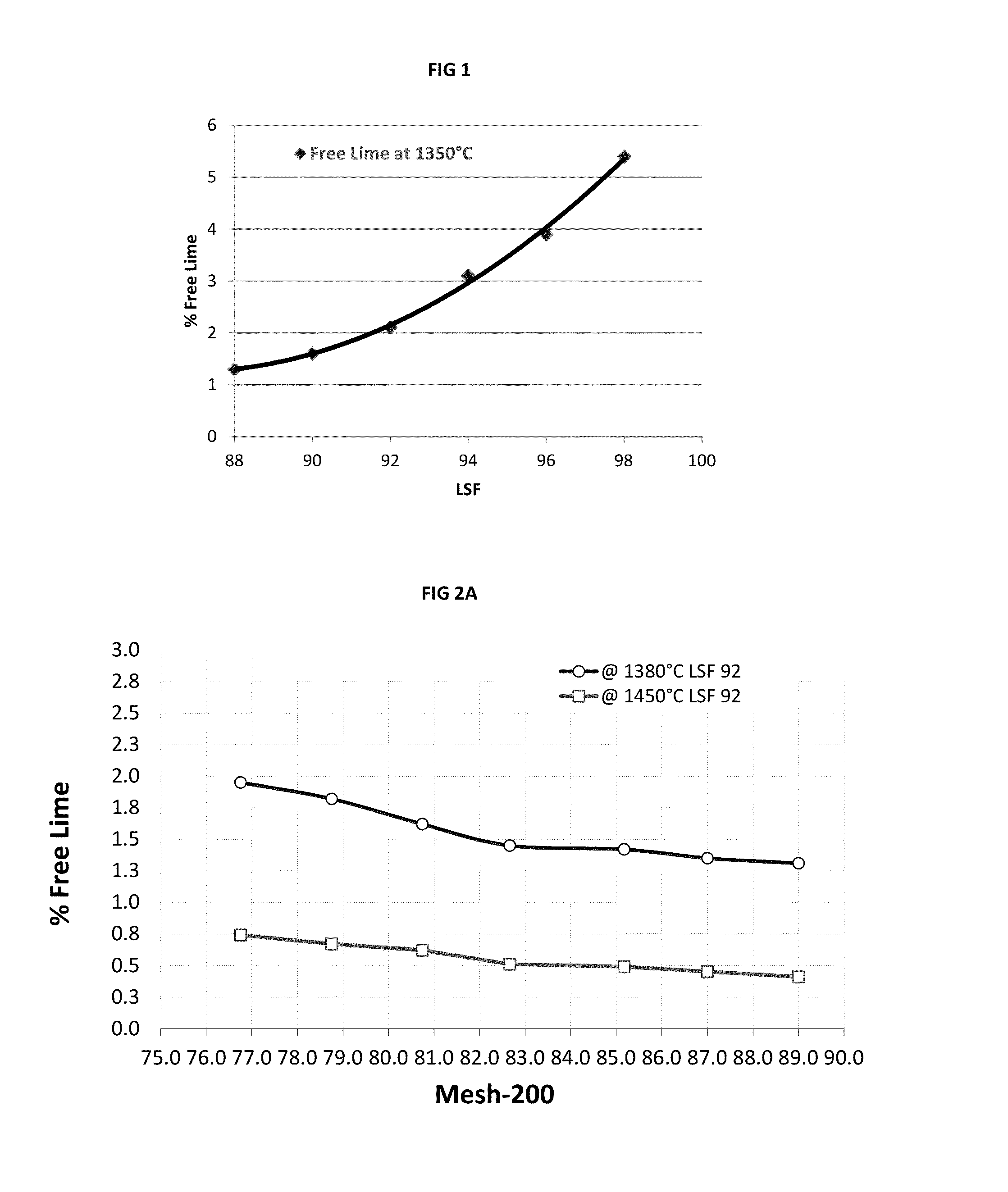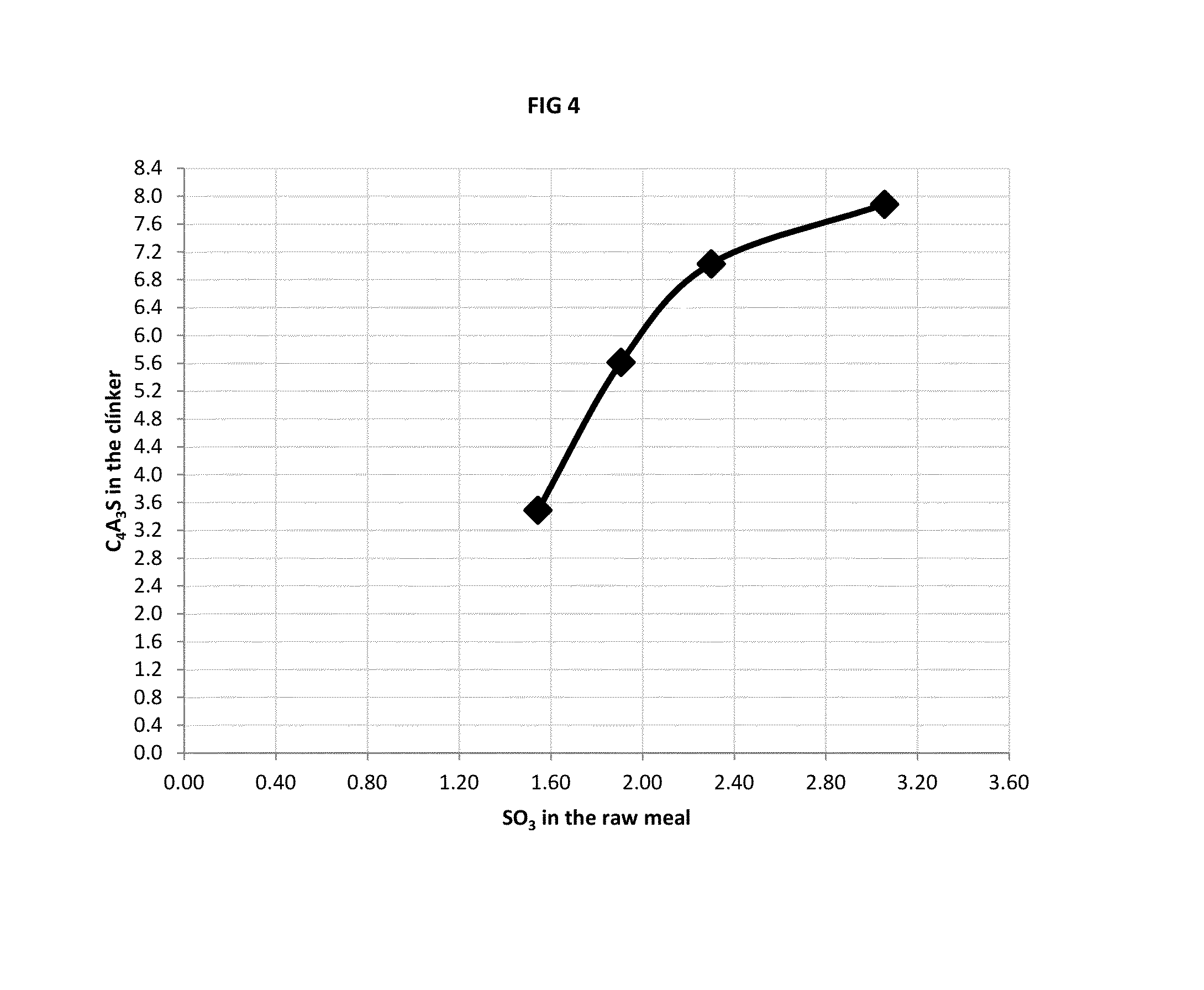Method for producing a clinker for hydraulic cement with low CO2 emission and high resistance
a technology of hydraulic cement and clinker, which is applied in the field of new clinker families, can solve the problems of high cost of supply, difficult commercialization of this type of cement, and uneven distribution of deposits, so as to reduce the energy level required, reduce the temperature of the eutectic, and reduce the cost of production
- Summary
- Abstract
- Description
- Claims
- Application Information
AI Technical Summary
Benefits of technology
Problems solved by technology
Method used
Image
Examples
example 1
[0049]The composition of a clinker comprising a low carbon content comprises 73% limestone and 22% kaolin, in addition to agents which promote the formation of the clinker phases at low temperature. The chemical analysis of the clinker obtained is presented below:
[0050]
Chemical analysisSiO2%22.80Al2O3%4.80Fe2O3%0.35CaO%65.28MgO%0.88SO3%4.18Na2O%0.27K2O%0.19TiO2%0.25P2O5%0.06Mn2O3%0.00CaF2%0.49Free CaO%1.10Control moduliLSF93.6SM4.4AM13.7
[0051]Appropriate control of the sintering temperature in the rotary kiln and of its cooling, preferably by a grid heat exchanger, makes it possible to obtain the mineralogical composition of the clinker, taking as basis the Bogue equations for the potential phases:
[0052]
PhaseUnitValueAlite%48Belite%29Calcium sulfoaluminate%9Calcium aluminate%1Calcium aluminoferrite%1Anhydrite%5Free lime%1
[0053]COMMENT: The C3A and C4A3S phases are distinguished by X-ray diffraction, which explains that the aluminum taken into account in calculating the potential pha...
example 2
[0056]By using 71.2% of limestone, 10.2% of a material rich in Al2O3, 11.5% of high-alumina kaolin and agents which promote formation of the phases of the clinker, the raw meal is obtained which, once heated at 1350° C. in a rotary kiln, produces a clinker having a low carbon content, the chemical composition of which is as follows:
[0057]
Chemical analysisSiO2%21.82Al2O3%5.54Fe2O3%0.81CaO%63.89MgO%0.87SO3%5.53Na2O%0.56K2O%0.47TiO2%0.16P2O5%0.04Mn2O3%0.00CaF2%0.53Free CaO%1.23Control moduliLSF93.8SM3.5AM6.8
[0058]After having confirmed, by the X-ray diffraction technique, the stabilization of the calcium sulfoaluminate in the clinker, the potential phases of the latter are calculated using the Bogue equations, which gives the following results:
[0059]
PhaseUnitValueAlite%40Belite%32Calcium sulfoaluminate%10Calcium aluminate%1Calcium aluminoferrite%3Anhydrite%7Free lime%1
[0060]COMMENT: The C3A and C4A3S phases are distinguished by X-ray diffraction, which explains that the aluminum taken ...
example 3
[0064]A clinker is sintered in the laboratory using 75.7% limestone, 17.5% waste material rich in Al2O3 and the components which promote the phases of the clinker at low temperature; the material obtained exhibits the following chemical composition:
[0065]
Chemical analysisSiO2%20.46Al2O3%7.28Fe2O3%0.89CaO%63.68MgO%0.52SO3%7.25Na2O%0.41K2O%0.72TiO2%0.33P2O5%0.13Mn2O3%0.03CaF2%0.52Free CaO%1.01Control moduliLSF95.8SM2.5AM8.2
[0066]The analysis of the clinker by the X-ray diffraction technique confirms that virtually all the aluminum is combined with the formation of the calcium sulfoaluminate and that there is no formation of C3A but only of C4AF, which is stabilized due to the content of Fe2O3 present in the raw meal. The mineralogical composition of the resulting clinker is as follows:
[0067]
PhaseUnitValueAlite%33Belite%34Calcium sulfoaluminate%13Calcium aluminate%1Calcium aluminoferrite%3Anhydrite%9Free lime%1
[0068]COMMENT: The C3A and C4A3S phases are distinguished by X-ray diffracti...
PUM
| Property | Measurement | Unit |
|---|---|---|
| temperature | aaaaa | aaaaa |
| temperature | aaaaa | aaaaa |
| temperatures | aaaaa | aaaaa |
Abstract
Description
Claims
Application Information
 Login to View More
Login to View More - R&D
- Intellectual Property
- Life Sciences
- Materials
- Tech Scout
- Unparalleled Data Quality
- Higher Quality Content
- 60% Fewer Hallucinations
Browse by: Latest US Patents, China's latest patents, Technical Efficacy Thesaurus, Application Domain, Technology Topic, Popular Technical Reports.
© 2025 PatSnap. All rights reserved.Legal|Privacy policy|Modern Slavery Act Transparency Statement|Sitemap|About US| Contact US: help@patsnap.com



